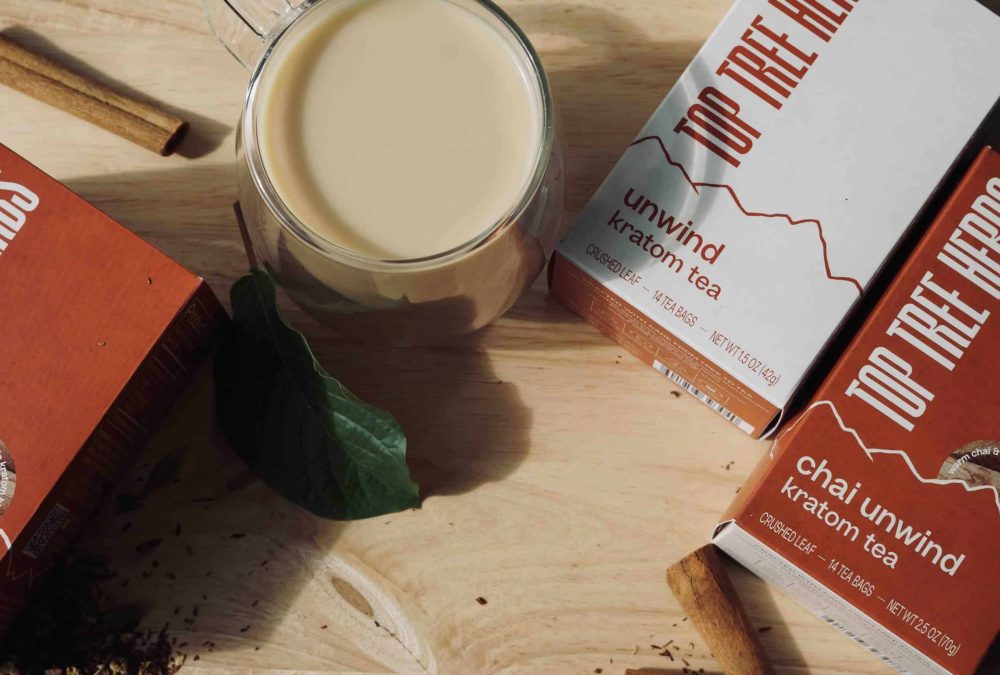Whether you’re a frequent tea drinker or a kratom consumer new to kratom tea, you might wonder, “When is the best time to take kratom tea?” Some people think of tea as an afternoon pick-me-up or as part of their evening wind-down routine. Should you drink kratom tea in the morning? Or is it better to take kratom before bedtime?
Well, if you want to learn the ins and outs of “how to drink kratom,” you’re in the right place. While there isn’t really a “bad” time of day to consume kratom tea, there are several factors you may want to consider when deciding when to take kratom.
Using what we know about the science behind kratom and its alkaloids, let’s look at some of the factors you should consider before determining when it’s best to brew up a delicious cup of kratom tea.
- Choosing which type of tea to drink
- When to drink white vein teas
- When to drink green vein teas
- When to drink red vein teas
- Serving sizes and how to brew
When to Take Kratom: Strains & Time of Day Matter
If you want to know when’s the best time to take kratom, well first, rather than merely asking, “What’s the best time of day to drink kratom?” you may find it more beneficial to ask yourself, “What is my particular motivation for drinking kratom tea?” Do you want to drink kratom tea for morning motivation, afternoon relaxation, evening rest, or another purpose?
There are different types of kratom, including different products, colors, and strains. Deciding when to take kratom not only depends on what kratom color/strain you want to take, but also what your “vibe” is. Do you want to settle down, chill, or enjoy a mindful moment of reading a book? It’s a little bit difficult at first to know exactly which kratom tea strain to drink at a given time, but as you get used to drinking kratom tea, you’ll figure it out in due time.
That being said, we’re here to help you take a look at some kratom strains to figure out when’s the best time to enjoy a serving of kratom, wherever you may be.
Kratom Tea Strains: Fact or Fiction?
If you’re reading this post, it’s extremely likely that you’ve already seen a few kratom tea strains in your online travels.
So what does a kratom strain with a name like “Green Malay” or “Red Bali” actually mean for kratom consumers or tea drinkers? Well, for starters, the color of the so-called “strain” refers to the vein color of the kratom leaf. The three main vein colors that you’ll likely see advertised are white, green, and red vein kratom. The second part of the strain, like Malay, Borneo, or Bali, references the region from which the strain supposedly originates (although most kratom in the US comes from Indonesia).
Interesting factoid: “Maeng Da” is a Thai slang word and literally translates to “pimp” (and it also refers to a type of beetle in Thailand). This word makes reference to “pimp grade” kratom, alluding to the strength of the Maeng Da strain. Maeng Da strains supposedly originated in Thailand.
However, as you know, some things are not always quite as they appear, and there’s still a lack of knowledge on the science behind kratom strains. The bottom line is, when it comes to kratom strains, things are not so cut and dried.
The Truth About Kratom Strains
If you’re not familiar with the myths about kratom strains, and haven’t read the previous posts on strain myths, we’ll give you a quick recap.
In short, vendors often exaggerate claims that the various vein colors and strains of kratom they sell are very different. All the strains they advertise come from the same kratom trees, the species with the scientific name Mitragyna speciosa. That’s actually why Top Tree stopped using kratom strains in mid-2023.
Kratom trees can have markedly varied alkaloid profiles in their leaves, which are usually influenced by lighting conditions and other environmental factors. However, in most kratom products for sale in the United States, the post-harvest process methods used to prepare the kratom leaves have a larger impact on the final product than the growing conditions of the kratom trees.
In Indonesia, workers in drying houses use different methods to bring out different alkaloid profiles in the kratom leaves. Lighting conditions and length of drying time are regarded as the most influential factors in producing the different types of kratom colors and strains.
Lastly, vendors may use their own processing methods, such as alkaloid extraction or mixing different strains, to create stronger kratom products or proprietary house blends of kratom powder. If the kratom vendor does not keep track of the different batch numbers during the manufacturing process, customers may notice the inconsistency of their “strains” over time. One batch might be a bit “fresher” than the next, or appear to be a different hue of green.
To ensure better consistency and proper manufacturing practices before you buy kratom, you should always check a kratom vendor’s certificates of analysis (COAs) to get an idea of which alkaloid percentages are higher or lower in different strains (most COAs only cover two alkaloids; mitragynine and 7-hydroxymitragyinine. You can also glean other useful information from lab test COAs, such as total mold count or other sanitary measurements.
Strain Reliability
The geographical terms used to describe a particular strain (Borneo, Malay, Maeng Da, etc.) are liberally applied to kratom as well. In fact, most of the kratom for sale in the United States comes from Indonesia, often from the Kalimantan region. This is why it may actually be more appropriate to refer to these strains as regional blends.
So, how do you know which strain (or blend) will produce a particular effect?
In short, you won’t. Even with laboratory testing, there’s not really a consensus in the kratom world as to what combination of kratom’s alkaloids constitutes a “Red Bali” or “Green Malay” strain. So to sum it all up: you should choose a strain not just based on its name, but on the benefits you receive from it and its overall quality.
Choose a kratom vendor that is reputable and honest about their strains. At the very least, they will have had their kratom strains lab tested for purity and potency, and vetted by members of their team/community to increase consistency from batch to batch. It’s an imperfect solution, but it’s better than taking a shot in the dark. Now that you’re aware of the degree of trust you can put towards kratom strains’ labeling, what strains are best for your particular needs?
A quick aside before we get started: Even after taking into account a vendor’s reputability and variations in strains, please keep in mind that individuals are unique. One person’s experience with kratom can differ from another’s due to alkaloid profile, kratom serving size, experience level with kratom, personal physiology, and the foods/drinks/supplements consumed in tandem with kratom tea. Always use your best judgment when drinking kratom tea. After all, our main goal is to provide a safe and enjoyable kratom experience for all consumers!
Now let’s take a look at the best times to drink kratom tea of different vein colors and varieties.
When to Drink White Vein Kratom Tea
The first batch of kratom strains we’ll touch on are white vein kratom tea strains. Some of the most popular strains in this category include White Borneo, White Maeng Da, and White Thai.
Energizing and Motivating without Caffeine
In general, white vein kratom teas are an excellent option to replace your morning cup of joe. Accordingly, white vein kratom tea strains are the go-to strain for a quick pick-me-up, making them an ideal option for kratom consumers that plan to engage in physical activity.
In fact, farmers and laborers in Southeast Asia have utilized kratom in this manner for centuries. Traditionally, workers would chew the leaves of the kratom tree while completing their tasks. This helped them combat the physical toll of their labor and other duties.
Motivational Moments
You can drink white vein kratom tea strains any time you would normally opt for caffeine. This can be during a typical workday morning, before an all-night study session, or as a pre-workout before you max out on your next flat bench session. Kratom’s efficacy as a pre-workout aid is unmatched, as shown by the popularity of the plant recently reaching record heights. Many consumers find that kratom provides an energizing boost to their activity, without the unwanted jitters associated with caffeine.
However, we should note that kratom is a diuretic – it belongs to the coffee family of plants, after all (the Rubiaceae family). As such, consumers should drink a fair amount of water when drinking kratom tea, especially before physical activity.
When to Drink Green Vein Kratom Tea
Green vein kratom teas are generally considered a happy medium, falling somewhere on the scale between red and green vein kratom. This is why many consider green vein kratom strains to be an excellent “starter strain.”
Green vein kratom strains are also known for their reported ability to promote a general sense of calm and well-being.
Skip the Midday Slump with Peach Green Kratom Tea!
Mindfulness and Peace
As such, green vein kratom teas are an excellent option for midday activities. Drink these strains during your midday slump at work, while studying for an upcoming exam, before going rock climbing, or while head-bobbing to some tunes on a weekend afternoon.
Some of the most popular teas in this category include raw leaf green vein kratom (Balance) and peach mango tulsi green vein kratom tea (Tulsi Balance).
When to Drink Red Vein Kratom Tea
Generally speaking, red vein kratom teas are best reserved for nighttime endeavors. Red vein strains have earned their reputation as the go-to for relaxation. Kratom tea bags that combine chamomile and kratom are perfect for this sort of timing.
For reasons we’ve already mentioned, we hate to generalize kratom strains and their effects. However, red vein kratom tea strains are also generally considered one of the “stronger” kratom strains on the market. As you now know, this is not always the case.
Indulge in Relaxing Chai Kratom Tea
A study of 5 strains comparing the percentages of mitragynine and total alkaloids found that a green vein strain had the highest alkaloid content out of all varieites. While this might sound like green vein kratom is the strongest, it’s acutally relatively uncertain just how kratom’s alkaloids interact and synergize.
Perhaps this robust and more evenly distributed alkaloid profile gives green kratom tea its balance. Thus, if you’re new to kratom tea and aren’t sure which kratom color you should pick, you may wish to try out green vein kratom tea first, then go from there.
Or, you can always order a kratom sampler pack of different colors and blend varieties (and kratom tea thermos)!
Kratom Tea for Relaxed Moments
Red vein kratom strains are an excellent choice for those looking to wind down after a long day. Drink red vein kratom strains before nighttime activities such as watching a movie, nightly reading, or any other wind-down ritual you may have before going to sleep.
Love the bodily effects of red vein teas, and want to get these benefits at any time of day? Just stick with a small to moderate serving size. Alternatively, you can bolster the energizing effects of your red vein kratom tea with a teaspoon of cacao powder or an added bag of green tea.
Some popular red vein options include raw leaf red vein (Unwind) and chai red vein kratom tea (Chai Unwind).
When to Take Kratom Tea After Eating
Wondering if kratom tea goes well with food? Well, while many people prefer to space out eating and kratom, you can drink kratom after eating. Like many other teas, such as black tea, green tea, and oolong, you might find it ideal to consider how your meal and tea go together. So, when’s the best time to consume kratom tea after eating? It’s generally recommended to drink kratom tea after having a light snack about 30 mins to an hour before drinking kratom tea. The lighter the snack, the less time it takes before enjoying your tasty cup of kratom tea!
If you eat a big, heavy meal, chances are you won’t enjoy drinking kratom tea quite as much. It really deserves its own dedicated moment to appreciate! Nevertheless, if you play around with different snacks and beverages before or after drinking kratom tea and have found an ideal food or drink to have with kratom, let us know in the comments!
How to Brew Kratom Tea
So now that you know when to drink different “strains” of kratom tea, how do you actually make a palatable kratom brew? As always, our team at Top Tree has you covered. We’ve discussed this topic at length, but a reminder never hurts.
You’ll need just a few things to get the job done. These tools and ingredients include: 1-2 kratom tea bags, a thermos, boiling water, and some lemon or lime juice. The addition of an acid like lemon or lime juice increases the efficacy of alkaloid extraction from the tea leaves, but it’s entirely optional.
- Begin boiling your water. Add your kratom tea bags to your thermos and squeeze a bit of lemon juice onto them.
- Once your water is boiling, pour it into your thermos and seal it.
- Let the mixture steep for 15-25 minutes, depending on your desired strength. This may seem like a long time relative to other teas you’re used to, but the extended steep allows for all of the alkaloids to be released from the tea leaves. After steeping, simply pour a cup and enjoy!
That’s all there is to it! If you’d like, you can also add sweeteners, spices, and a wide variety of other mix-ins to your tea. If you’d like some more detailed information on how to make kratom tea creatively, check out our kratom tea recipes on the Better Brewing Blog.
Recap
Before we part, let’s take a look at what we’ve learned today in our guide to When to Drink Kratom Tea.
- When considering when to drink kratom, you should also consider what your motivation for drinking kratom actually is. Are you just waking up for the day, heading out for a jog, or about to hit the hay? Your answer to this question should give you some guidance.
- Kratom strains are not always what they appear to be. All strains come from the same Mitragyna speciosa kratom tree.
- While it is true that different strains can certainly achieve different results, vendors may not even be sure of the origin and alkaloid profile of the kratom they’re advertising.
- With all of that information on the table, we do have a general guideline.
- White vein strains for a boost of energy
- Green vein strains for a midday pick me up
- Red vein strains for nighttime relaxation
- Our guidelines should be taken with a grain of salt, as factors like serving size and experience with kratom also play a major role in a strain’s range of effects.
Whew! We know that’s a lot of info to take in. However, if you’ll stick around for just a bit longer, we have some exciting news!
Kratom Tea Recipe Book!
For special moments in which you want to socialize or host a kratom tea party, check out Top Tree Herbs’ seasonal kratom tea recipe book! Within the e-book, you’ll find five of our favorite holiday kratom tea recipes that are sure to take your kratom tea to the next level. Along this line, if you’re running out of ideas for the gift-giving season, we suggest checking out our Holiday Gift Guide! Here you’ll find unique kratom-related gift ideas that are sure to keep you on the “nice list” for the rest of the year.
When To Take Kratom: Final Thoughts
If you’re still wondering, “When is the best time to take kratom,” hopefully, we’ve answered your questions. If you’re still left with more questions about kratom (it is a very fascinating plant!), feel free to browse our informative blog posts on topics such as kratom laws, kratom science, kratom tea culture, and more!
Lastly, when choosing where to buy kratom tea, we recommend a vendor who supports kratom regulation, offers third-party lab tests, takes care to label their products correctly, and is responsive to customer requests. As a kratom tea vendor ourselves, we believe that we set the bar pretty high when it comes to what to look for when choosing a kratom vendor (and avoiding bad kratom vendors as well). Cheers, and happy brewing!





